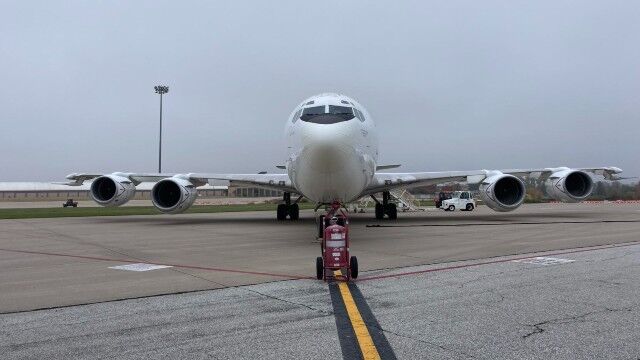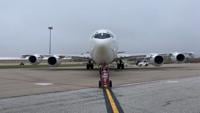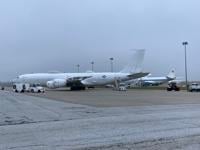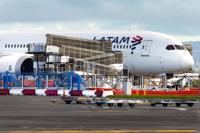
The E-6B Mercury is a communications relay and strategic airborne command post aircraft.
It’s the backbone of America’s national security - the U.S. nuclear triad.
Through bombers (air), submarines (sea) and intercontinental ballistic missiles or ICBMs (land).
It’s critical these weapon systems are routinely tested, to assure our allies and partners that we stand ready and to deter our adversaries from attack, but how do you test these programs without launching an actual nuclear warhead and inflicting total chaos and destruction?
Eighth Air Force invited WAAY 31 to the heartland, to the U.S. Strategic Command Base for an exclusive look into a one-of-a-kind mission.
“The goal is to not be seen, not to be heard, but to be prepared and that’s exactly what we do. We practice, we test, we validate, we operate so that if we ever need to do our mission we’re able to do so,” said 625 STOS/ALCS Test & Analysis Flight Commander, Maj. Cameron Reese.
Three to four times a year, the U.S. conducts a Glory Trip Mission.
“A Glory Trip is a test launch of the Minuteman III ICBM,” explained 625 STOS Commander, Lt. Col. John Grimes. “They are launched out of the Vandenberg Space Force Base, just north of the Los Angeles area."
It gives Air Force Global Strike command the opportunity to test an unarmed Minuteman III intercontinental ballistic missile.
“What that does is it validates the capability for our nation, and demonstrates on the national stage, the capability, which is critical to our nuclear deterrent force,” said Grimes.
“(But) our portion of that is we serve as the back up to our underground launch facilities,” explained 625 STOS/ALCS Training & Evaluation Flight Commander, Capt. Raun Carnley.
“It’s a one-of-a-kind squadron that has just a critical role in the ICBM mission,” Grimes added.
The 625th Strategic Operations Squadron provides the only alternate launch capability of our ICBM source from the silos.
“For 625th STOS, ICBM operations start and end with us,” explained Reese. “The reason we say that is because we have some elite men and women who are able to target, provide targeting for our ICBMs. We also have some elite men and women who are able to launch those ICBMs so you got to start with targeting and you got to end it with execution with the idea that we never actually execute.”
The aerial launch happens once a year and it costs roughly $18 million to execute.
“We also need to test our capability from the aircraft perspective,” echoed Carnley. “We’re testing the reliability of the weapon system, but also the airborne capability to ensure that we are still able to communicate with the missile properly and launch it if needed.”
“There should be no fear associated with this. The test schedule is five years in the making, this is purely for testing the weapon system, to make sure it is performing as prescribed and is not related to any kind of world event, or any kind of escalation whatsoever, so this is routine business,” expressed Grimes.
“The men and women that work on these platforms put a lot of blood sweat and tears to make sure that the American people are safe, they are protected,” Reese added.
“We are excited to be a part of something that allows individuals to have that sense of security and peace, and be able to enjoy life and not really worry about whether they are going to be waking up safely at night or whether they’re going to have to be worried about their family because we are doing our job,” said Carnley.

The E-6B Mercury sits on the flight line at Offutt Air Base. One of the key components, vital in our country is nuclear command, control communication.
From nose to tail, this aircraft is considered a flying skiff, which means that contains classified information throughout and you have to have a specialized clearance just to get on board.
The aircraft itself is a Navy jet, but the operators on board are Air Force.
The operators train year-round in the virtual airborne procedures trainer.
“This is where we do all of our training before actually getting onto the bird,” explained Reese. “So first we will start out here for initial training and we also do reoccurring training in this VPT as well. We have two of these and it operates very similar to the ALCS the air control launch control system does on the bird.”
“This is a mock up of what’s actually on the jet position or just slightly different because we do have it on screens,” said Carnley as he walked WAAY 31 through the trainer. “(But) if you look very closely, you’ll still see some scratch marks on some of them they did a very good job of actually capturing real pieces of equipment and digitally re-creating them for us so functionality is the same and even look is the same down to the scratches.”
Not to mention it’s cost effective.
“It’s great to have this here. We had a flood in 2019, during that time we were sending some of our trainees over to Vandenberg so they could continue with their training, but having this here is great, we’re housed here at Offutt, our offices are right across the hallway, so having a trainer here having two of them makes it super easy for our guys to stay trained up,” Reese explained.
“We want to make sure that they are going to be able to turn those keys and fulfill that mission regardless of what’s happening,” Carnley added.
“This type of job you’re training to the T every time every time,” said 625 STOS/Combat Operations Flight Commander, Capt. Eric J. Maloney. “A lot of people, American citizens and allies are kind of counting on you to make sure you’re doing it right every single time.”
“It is such a critical thing to make sure we are safe in every aspect because of how devastating these weapons can be,” said Carnley. “We need to make sure that we have that nuclear surety, that safety with everything that we do; so in order to help protect that we are under personnel reliability programs, to make sure we are still of sound mind - that if any time we run into a situation to where we are not feeling like we are our best, that we won’t be in the situation to operate the weapon system.”
“We’re doing everything independently but we’re verifying that we’re both taking the same steps to eventually get to the key, turning at the exact same time to provide and ensure that two people are taking the correct actions and verifying that those actions are correct to launch that missile,” added Maloney.
“The message is while you don’t hear about us but we’re out there,” Grimes said. “That ICBM mission here at the 625th STOS we are out there, working hard in defense of our country and we’re ready. The American people, our allies can rest easy, knowing that we are out there doing our job and we’re okay with being that unsung aspect of the Air Force and mission.”
Execution is followed by weeks of analysis, ensuring the procedures are effective and the system operates as it should - fulfilling the three C’s of deterrence - capability, commitment and communication to both our allies and adversaries that we stand ready around the clock. That’s the airborne launch control Glory Trip. What you may not know is the other Glory Trips conducted on land throughout the year are headquartered right here in our own backyard.
“The Glory Trip missions are a perfect example of the joint force coming together. Every Glory Trip mission includes members of the Army and Navy, the Air Force and Space Force working as one, one team,” said Army COL Juan Santiago, director of the Reagan Test Site.
The Reagan Test Site is located at the U.S. Army Garrison-Kwajalein Atoll, Republic of the Marshall Islands in the Central Pacific Ocean.
“It allows us to have a broad ocean area to test novel technologies,” explained Santiago. “Doing tests like that over the broad ocean area allows us to do things that we wouldn’t necessarily be able to do for safety over the United States.”
Allowing them to push the limits on new and pre-existing programs.
“We test things that are very important to our national security so intercontinental ballistic missiles, certain hypersonic tests, space testing,” he added. “The Reagan Test Site has an operation center here in Huntsville, Alabama. From here in Huntsville, Alabama. It allows us the opportunity to collaborate and plan missions with our mission partners. It also brings us closer to our headquarters Space and Missile Defense Command.”
Commands are sent remotely from Huntsville, to Vandenberg Space Force Base, to the Marshall Islands — that’s over 7,000 miles in fractions of a second. In addition to the three to four Glory Trips a year, the Reagan Test Site also supports customers from the Department of Defense as they develop technology and capabilities critical to both national and global security. These tests don’t just happen overnight. In most cases they are months, even years in the making.
“Every test is special. Every test is unique,” said Santiago. “We package all the data that we collected during the test and we provide that data to the customer and it really helps them inform their programs as to whether their system is performing as expected or if they need to make adjustments."
This role and mission carries an even greater responsibility for Santiago.
“I’m really proud to serve as the director of the Reagan test site here in Huntsville, Alabama. I’m a proud graduate of Butler High School and a proud graduate of the University of North Alabama, so I’m just extremely humbled and proud that I’m able to continue to serve our Army and our community in this capacity.”
Providing a joint force effort while uniting all the components that are key to our national defense.
Santiago added, “One of the great things about the Reagan Test Site being here in the Rocket City, is that for the Glory Trip mission there are industry partners that are very important to the program; so being here in Huntsville is great for our team, because it allows us to collaborate, not only with the Air Force or our mission partners, but also those industry partners that are critical to the success of our mission.”
Boeing’s Huntsville location is just one of those industry partners. Boeing has been involved in the Minuteman program - Minuteman I, II and III since the inception.
“When the Air Force initially contracted with us (Boeing) 65 years ago we were able to deploy the first system within four years, that’s a testament to how important this weapon system is to the nation and Boeing has been involved in this weapons system for those 65 years and we will continue to support that weapon system at through the end of the 2030s,” explained Ted Kerzie, deputy leader for Boeing’s Strategic Missile & Defense Systems and director of Boeing’s Strategic Deterrence Systems. He continued, “Specifically here in Huntsville is a program called ICBM Cryptography Upgrade 2, which is a second phase of a program and the circuit cards are actually built right across the parking lot and the ICU2 program gives the Air Force capability, really kind of in the current century capability, to do remote code change.”
Instead of physically sending people out to the silos to insert new crypto codes, Huntsville helped create its remote capability.
“The Minuteman Weapon System is across six states, there’s 450 silos and the circuit cards that we build here touch every message that goes across the weapon system, so that is huge and that's important for the nation. It’s important for the people of the nation and of course for Huntsville and delivering this product.”
“It’s an awesome feeling for the employees that work for Boeing and this weapon system, it goes beyond just doing this for the company, it’s doing this for the nation,” Kerzie added.
Just like their military counterparts, Boeing staff are on alert 24/7 - the peace and security of our nation depends on it.
“We are continuously monitoring the weapon system, the system is always on, missiles always powered, the guided systems are always spinning, so we have folks - employees that look at it day-to-day, how the weapon system’s operating and report that to the Air Force to make sure it’s ready on a moment's notice.”
America's ICBM force has remained on continuous, around-the-clock alert since 1959. The Ground-Based Strategic Deterrent program will begin the replacement of Minuteman III and modernization of the 450 ICBM launch facilities in 2029.
WAAY 31 was given rare, exclusive access to the 625th STOS at Offutt Air Force Base and this mission set. We’d like to extend a sincere thank you to Air Force Global Strike Command, 8th Air Force, 625th Strategic Operations Squadron, U.S. Army Space and Missile Defense Command, the Reagan Test Site Operation Center and Boeing for making it possible. With Special thanks to Justin Oakes, Staff Sgt Codie Trimble and Senior Airman Joshua Carroll.
Click here for our previous story- WAAY 31 Special Report: Doomsday Plane provides power in the sky
WAAY 31 News Anchor Marie Waxel gives you an exclusive look into a vital part of our national security.














